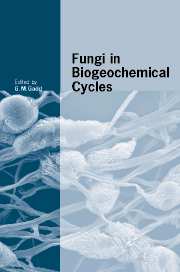Book contents
- Frontmatter
- Contents
- List of Contributors
- Preface
- 1 Geomicrobiology: relative roles of bacteria and fungi as geomicrobial agents
- 2 Integrated nutrient cycles in boreal forest ecosystems – the role of mycorrhizal fungi
- 3 Fungal roles in transport processes in soils
- 4 Water dynamics of mycorrhizas in arid soils
- 5 Integrating ectomycorrhizal fungi into quantitative frameworks of forest carbon and nitrogen cycling
- 6 Role of arbuscular mycorrhizal fungi in carbon and nutrient cycling in grassland
- 7 The role of wood decay fungi in the carbon and nitrogen dynamics of the forest floor
- 8 Relative roles of bacteria and fungi in polycyclic aromatic hydrocarbon biodegradation and bioremediation of contaminated soils
- 9 Biodegradation and biodeterioration of man-made polymeric materials
- 10 Fungal dissolution and transformation of minerals: significance for nutrient and metal mobility
- 11 Fungal activities in subaerial rock-inhabiting microbial communities
- 12 The oxalate–carbonate pathway in soil carbon storage: the role of fungi and oxalotrophic bacteria
- 13 Mineral tunnelling by fungi
- 14 Mineral dissolution by ectomycorrhizal fungi
- 15 Lichen biogeochemistry
- 16 Fungi in subterranean environments
- 17 The role of fungi in carbon and nitrogen cycles in freshwater ecosystems
- 18 Biogeochemical roles of fungi in marine and estuarine habitats
- Index
- References
8 - Relative roles of bacteria and fungi in polycyclic aromatic hydrocarbon biodegradation and bioremediation of contaminated soils
Published online by Cambridge University Press: 10 December 2009
- Frontmatter
- Contents
- List of Contributors
- Preface
- 1 Geomicrobiology: relative roles of bacteria and fungi as geomicrobial agents
- 2 Integrated nutrient cycles in boreal forest ecosystems – the role of mycorrhizal fungi
- 3 Fungal roles in transport processes in soils
- 4 Water dynamics of mycorrhizas in arid soils
- 5 Integrating ectomycorrhizal fungi into quantitative frameworks of forest carbon and nitrogen cycling
- 6 Role of arbuscular mycorrhizal fungi in carbon and nutrient cycling in grassland
- 7 The role of wood decay fungi in the carbon and nitrogen dynamics of the forest floor
- 8 Relative roles of bacteria and fungi in polycyclic aromatic hydrocarbon biodegradation and bioremediation of contaminated soils
- 9 Biodegradation and biodeterioration of man-made polymeric materials
- 10 Fungal dissolution and transformation of minerals: significance for nutrient and metal mobility
- 11 Fungal activities in subaerial rock-inhabiting microbial communities
- 12 The oxalate–carbonate pathway in soil carbon storage: the role of fungi and oxalotrophic bacteria
- 13 Mineral tunnelling by fungi
- 14 Mineral dissolution by ectomycorrhizal fungi
- 15 Lichen biogeochemistry
- 16 Fungi in subterranean environments
- 17 The role of fungi in carbon and nitrogen cycles in freshwater ecosystems
- 18 Biogeochemical roles of fungi in marine and estuarine habitats
- Index
- References
Summary
Introduction
Polycyclic aromatic hydrocarbons (PAHs) are a large group of toxic compounds (Fig. 8.1) that are components of coal and petroleum and are also produced during incomplete combustion of fuels. They are introduced into the environment via many routes, including fossil-fuel combustion, automobile and diesel engine exhausts, production of manufactured gas and coal tar, wood-preservation processes and waste incineration (Harvey, 1997; Pozzoli et al., 2004). Benzenoid PAHs are thermodynamically stable, with positive bond resonance energies (Aihara, 1996), and have vapour pressures of 2.8 × 10− 5 to 10.4 Pa (Sonnefeld et al., 1983). The aqueous solubility of PAHs ranges from 0.2 μg/l for indeno[1,2,3-cd]pyrene and 1.6 μg/l for benzo[a]pyrene to 31.7 mg/l for naphthalene (Lehto et al., 2003). Despite their low solubility, PAHs are widely distributed in the environment (Wilcke, 2000; Saltiene et al., 2002; Peachey, 2003; Pozzoli et al., 2004) and, as persistent organic pollutants, they are involved in biogeochemical cycling (Del Vento & Dachs, 2002; Jeon et al., 2003). The five-ring PAH, perylene, found in Jurassic sediments may even have originated from ancient fungi (Jiang et al., 2000).
Sixteen PAHs are on the lists of priority pollutants of the US Environmental Protection Agency and the European Union (Lehto et al., 2003); mixtures containing more than 50 individual PAHs have been found in sediments at hazardous waste sites (Brenner et al., 2002). Low-molecular-weight PAHs, with two or three rings, are the most volatile and usually the most abundant. High-molecular-weight PAHs, with four or more rings, are less volatile.
- Type
- Chapter
- Information
- Fungi in Biogeochemical Cycles , pp. 182 - 211Publisher: Cambridge University PressPrint publication year: 2006
References
- 13
- Cited by

